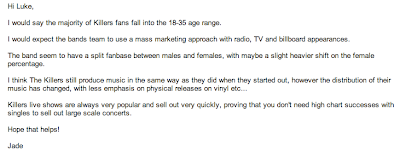There's a simple focus surrounding the front cover, as there's little in terms of content but the content that is there, is stunning, showing how the mise-en-scene has been thought of carefully in relation to composition. Part of the mise-en-scene is there's a purple overglow close to the top, giving the cover a bit of a techno display that goes within the attitudes and beliefs of alternative rock, especially as it hints at apocalypse and relationship themes. A wide shot shows the main figure staring into the distance, denoting that he's contemplating about life, but as Death Of The Author mentions, there's no single interpretation that can be given by the artist.
The figure is surrounded by what appears to be temple formations. These are possibly connoting deeper layers about apocalyptic themes, as the mode of address appears to be engaging audiences from a detached perspective. Imagine Dragon's logo stands out as the representation has an unusual slant, although it also appeals to the target demographic, being an audience that's younger than the age of thirty. This theory could prove to be correct as although the band haven't compromised the content of the lyrics, there's an appearance about the digipak that means the target demographic is inclined to be younger. Going back to the font of the band, the colour is white, potentially symbolising religion as in post-apocalyptic times, a form of salvation is having faith in God. Night Vision's heading fades in slightly, as the colour is still white but the decrease in size diminishes the heading to an extent.
Imagine Dragons are aiming at a modern audience, given their style presumably a younger crowd so the lower end of my age range might be in their range. The audience I'm going after is modern also; people who are up to date so modern themes are more likely to apply to this crowd, although perhaps not entirely in my age range. This is as the sixteen to twenty five range puts a limit in themes that can be explored.
A dark background stands out on the back, essentially being a signifier for how the subject matter's going to be portrayed, especially standing out with the font for the tracks as bold white. Codes and conventions are followed for back covers, as the tracks are listed and a web address is given as well as the record label, providing the necessary information for audiences to be able to research the band. headings which is suitable because it functions as a symbol for the subject matter that will be covered in this album. In keeping with the codes and conventions of albums, the tracks are listed using the same font as the subheading on the front, keeping with tradition as bands usually keep the same style or colour in some form across the album.
Referencing the inside panels of the digipak, it relates to the front cover through the use of cloud imagery, which conforms to conventions of there being a continuation of style, along with using the same diegesis. The inside panel doesn't exactly reflect the mise-en-scene of the front however, as although it uses the same lighting, positioning and other conventions, there are no temples or main figure shown.
Moving onto the CD, no information is listed apart from the band and album titles. There are lots of tiny circles, potentially symbolising an endless void and this is the iconography Imagine Dragons are attempting to represent. Copyright information is also commonly spread around the circle as the CD is the main content so audiences can know who the rights belong to, as well as other information. The font for "Imagine Dragons" and the subheading are kept in the style they're in on the sides of the album, the subheading a grey colour that is designed to distinguish it. This digipak doesn't signify enough creativity to be able to sell a large amount as it's the cover that looks creative, but the digipak combines enough to offer incentive towards it's audience and this will be a useful basis for knowing where the importance of attracting an audience is.

















